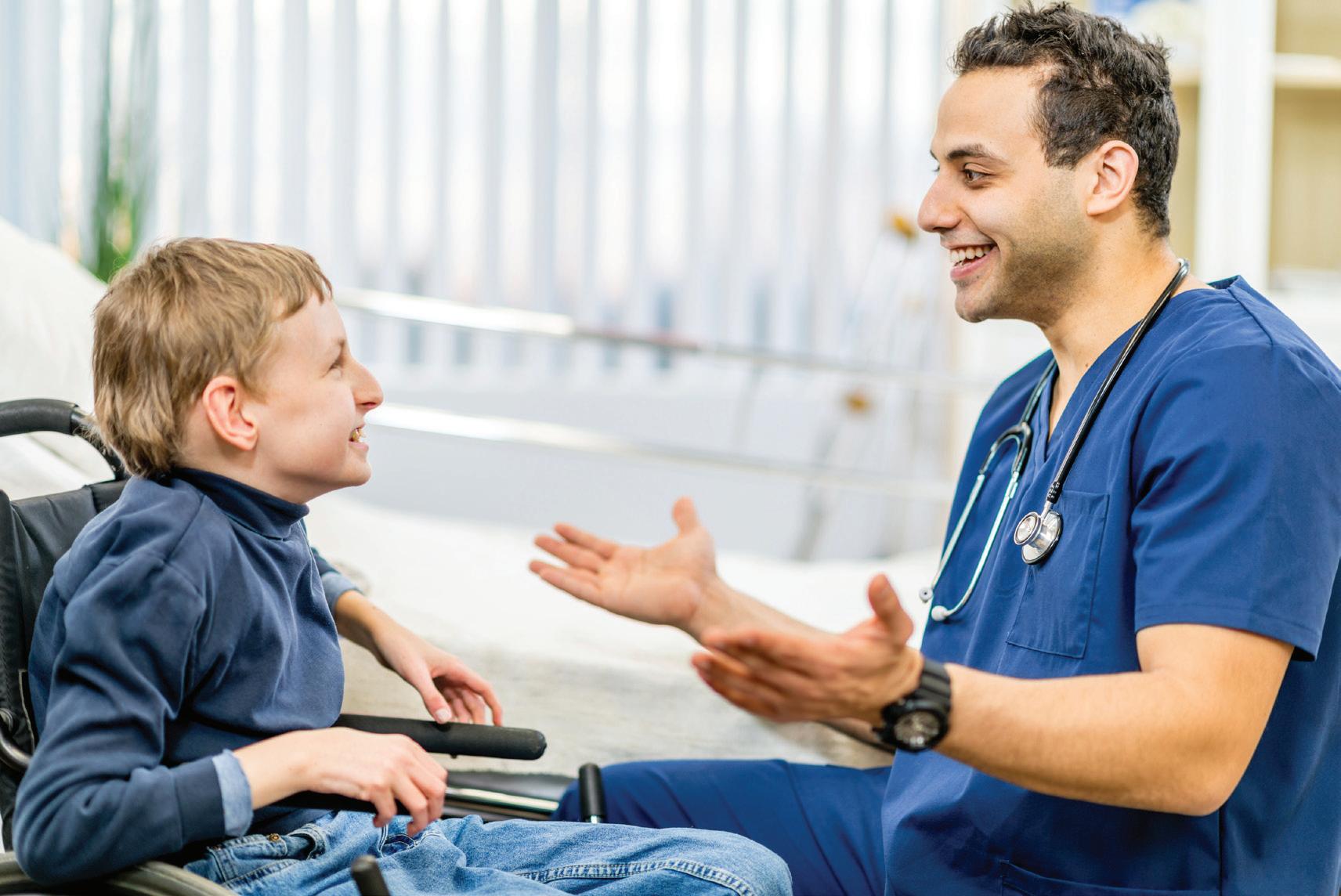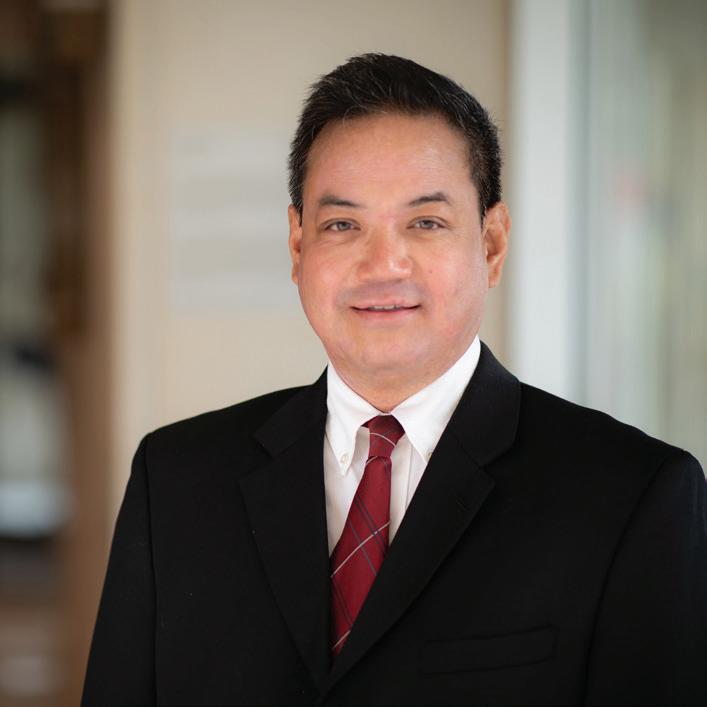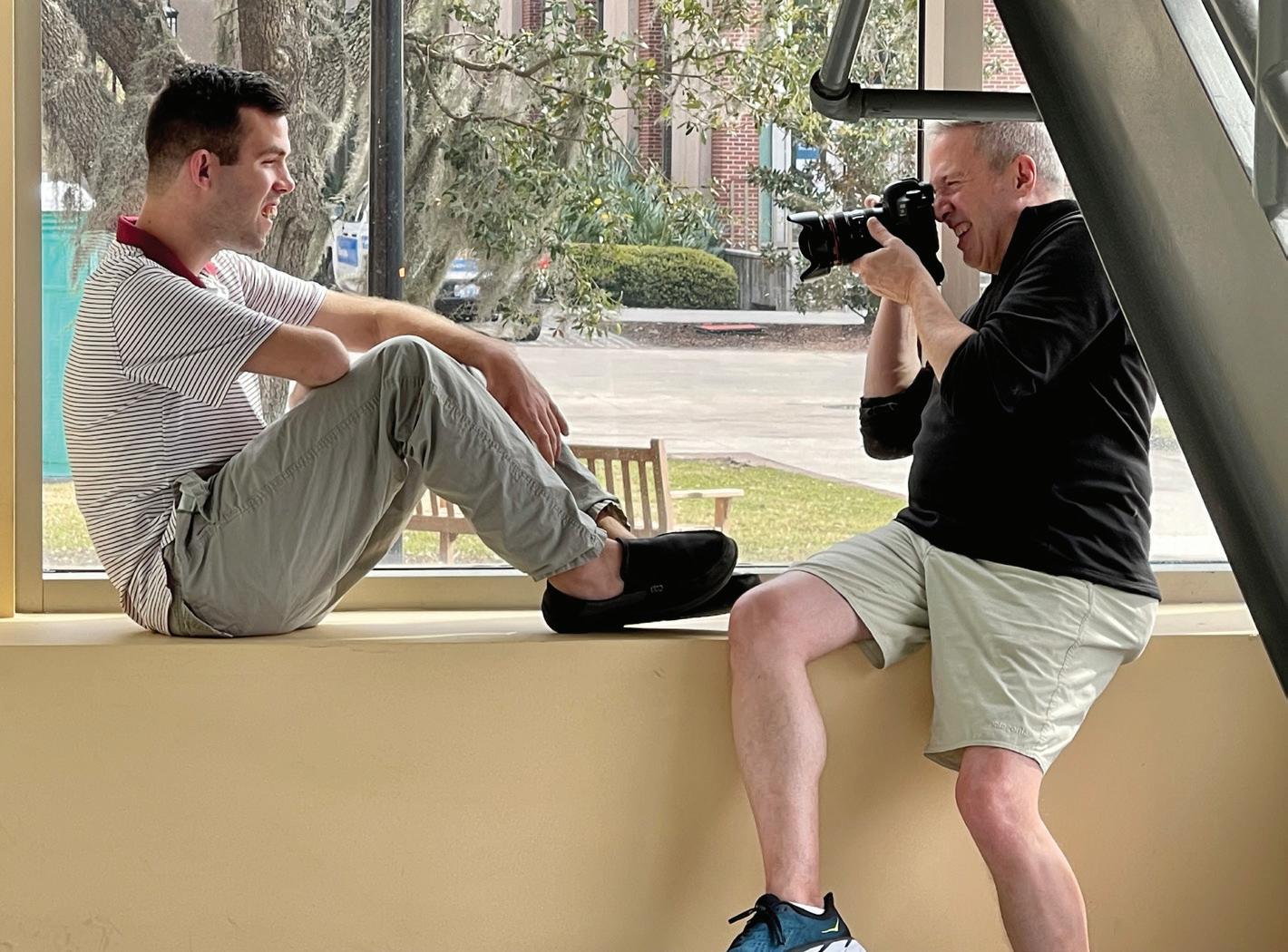
11 minute read
First Class
A Journey of
LEARNING
Advertisement
By Vincent Siasoco, MD, MBA
INITIAL TRAINING
After attempting to call a few places, I tried another clinic to set up a clinical rotation for my elective. I made the call and introduced myself, “Good morning. I’m a third-year family medicine resident and wanted to ask if I could do a clinical rotation at your clinic for patients with intellectual and developmental disabilities (IDD)?” Five to 10 seconds of initial silence passed by, at which point I was transferred to three different staff, and then finally asked for my name and contact number and told that someone would call me back. The following afternoon, I received a call from a kindly, albeit slightly surprised, medical director. A week later, the first elective of its kind in my program started.
Following years of schooling and countless sleepless nights in residency and searching for any type of experience with this underserved population, so began my first training for a two-week period…just a few weeks away from graduating from my residency program. BARRIERS TO CARE For a family member or caregiver caring for a loved one with IDD, the challenges are well known in accessing quality healthcare. Barriers such as attitudinal, physical, communication, and financial exist and have been highlighted by the World Health Organization.1 One of the main barriers is lack of training on how to care for this population.2
ONGOING TRAINING My two-week elective training flew by, as did graduation. After residency, I landed a job at a non-profit disability agency, working in their outpatient clinics in New York City. My education and training with this population had only just begun. I recall the first few days looking out into the waiting room, a mix of different faces, bodies, and sounds. As time went on, I became more comfortable being their physician. I got to know the patients and how to communicate with each. I began to understand where they lived and what their needs were. I met countless direct support professionals (“DSP”) and learned the importance of their roles. The intersection of primary, oral, and behavioral healthcare was highlighted as was the importance of avoiding diagnostic overshadowing. It took time and some of which was a trial by fire especially when it came to learning about state regulations, forms, and community support services (or lack thereof). Fortunately, I was able to find my way and learn how to care for this population with some of the best teachers being my own patients. DATA
Reports reveal two-thirds of adults with IDD have two or more co-morbidities including obesity and chronic mental health needs. More than 40% have been diagnosed with four or more chronic conditions in addition to IDD.3 Although individuals with IDD are living longer lives, over all, the average lifespan of those with IDD remains substantially lower than those in the general population.4
TRAINING OTHERS
Though my path was unique, I was cognizant about others who may not have had the opportunity, not sure where to turn, or worse, not want to be bothered to make the effort to learn about this population. As my career
took me on different paths, I made it a point to offer clinical rotations to medical students and residents at the clinics I worked at and give lectures when and where possible.
In 2018, I became a Clinical Assistant Professor in the Department of Family and Social Medicine at the Albert Einstein College of Medicine at Montefiore.
In 2019, the Albert Einstein College of Medicine received a grant that was part of the National Curriculum Initiative in Developmental Disabilities to develop a curriculum for 2nd year medical students on how to care for adults with IDD. It was funded by the American Academy of Developmental Medicine and Dentistry (AADMD) and Special Olympics International and the project led by Joanne Siegel, Co-Director of the Rose F. Kennedy UCEDD at Montefiore. Joanne had brought me on her team and, along with other academic leadership at Einstein, a curriculum was formed. What was meant to be a two-year program, was eventually approved to become a permanent part of the second-year medical student curriculum at Einstein.
In 2020, a fourth-year medical student, Alex, doing an elective research rotation with me focusing on patients with disabilities, had learned about the AADMD. He then took the lead and established a Student Chapter of the AADMD at Einstein. With Alex as president and I as the faculty advisor, our membership started out at a whopping four students.
As word got out about the Chapter, Alex graduating, and two new Chapter co-presidents coming on, membership grew in numbers of not only students but also residents and fellows. Through the Chapter and in partnership with Special Olympics NY and community-based organizations such as ADAPT Community Network, members thought of unique activities to get engaged with and learn from this population. Members not only took on the role of audience member at lectures or students in shadowing, but in leadership and advocacy roles to guide the Chapter forward.
As the current Student Chapter co-president and third-year medical student, Samantha DiSalvo, stated, “Growing up alongside my brother, Anthony, who has cerebral palsy, I have seen first-hand the barriers that individuals with intellectual and developmental disabilities face in our healthcare system. Working with the Einstein AADMD student chapter has allowed me to be an advocate for individuals like my brother and combat these barriers. It has been the key factor in bringing together like-minded future healthcare professionals with the goals of improving medical education and ultimately the quality of healthcare for this population.”
The NCD Health Equity Framework recommended, “requiring comprehensive disability clinicalcare curricula in all US medical, nursing, and other healthcare professional schools and require disability competency education and training of medical, nursing, and other healthcare professionals.” SUMMARY It’s been years since my first twoweek rotation in residency had opened the doors to this population as a physician in training. Each person’s journey of learning is different, based on the opportunities available to them. Much is still needed to continue improving access to education and training on how to care for those with intellectual and developmental disabilities.
The National Council on Disability Health Equity Framework recommended, “requiring comprehensive disability clinical-care curricula in all US medical, nursing, and other healthcare professional schools and require disability competency education and training of medical, nursing, and other healthcare professionals.” All need to continue to advocate for providing quality healthcare for this population but also for the training of future healthcare providers and leaders that will be serving them.

Vincent Siasoco, MD, MBA is an Assistant Professor, Departments of Family Medicine and Pediatrics, Albert Einstein College of Medicine, New York, NY. He is a Board Member at AADMD.
REFERENCES
1. Disability and Health. World Health Organization. https://www.who.int/news-room/factsheets/detail/disability-and-health. 2. Goode, Shaina, Causey-Upton, Renee. A Blind Spot in Health Care Services: The Intellectual/Developmentally Disabled Population and Training of Primary Care Providers. Kentucky Journal of Undergraduate Scholarship, Issue 2, (2018). Pgs. 62-72. 3. Ervin, David, Merrick, Joav. Intellectual and Developmental Disability: Healthcare Financing. Frontiers In Public Health, 24 September 2014 | https://doi.org/10.3389/ fpubh.2014.00160 4. Pimlott, Nicholas. Aging with intellectual and developmental disabilities. Can Fam Physician. 2019 Apr; 65 (Suppl 1): S3. helenjournal.org • HELEN | 13
A young woman with pale skin and long white hair, wearing a white top and black suit, smiles widely while standing confidently with her hands on her hips.

Positive Exposure:
TO BE SEEN, TO BE HEARD, TO BELONG
By Liz Matejka-Grossman Photographs by Rick Guidotti
Rick Guidotti, Founder and Director of Positive Exposure, photographs a young man wearing a striped golf shirt, khakis and loafers in front of large, sun-filled window. R ick Guidotti was a fashion photographer working in Milan, Paris, London and New York City for such clients as Revlon, L’Oreal, Elle and Yves St Laurent; shooting such iconic beauties as Claudia Schiffer and Cindy Crawford. But all this changed in 1997, when Guidotti embarked on the most important journey of his life – as an artist, a human being and the launch of Positive Exposure, a 501(c) arts organization that utilizes photography, film and narratives to transform public perceptions of people living with genetic, physical, intellectual and behavioral differences – from albinism to autism.
“As a fashion photographer, I was always told who was beautiful. I was told who the model of the moment was,” Guidotti explains. “As an artist, this was so frustrating because I saw beauty everywhere.”
Leaving his studio one afternoon, Guidotti spotted a young girl at a bus stop on Park Avenue. She had long white hair and pale skin – a condition called albinism. As Guidotti recalls, “I instantly realized that I had never met a model that looked like her and this beautiful girl had never been included in the beauty standard.”
Running to the nearest bookstore to get information on albinism, Guidotti was struck by the number of terrifying images depicting albinism and many other genetic and medical conditions. “These images were all the same – photographs of people up against walls in doctors’ offices, in their underwear or naked with black bars across their eyes, devoid of humanity,” Guidotti


exclaims. “Where were the photographs of this gorgeous girl I saw waiting for the bus?”
It was at the moment that Guidotti decided to refocus his lens to create an alternative to these traditional medical photographs and insist that beauty and humanity were ultimately recognizable. Guidotti contacted The National Organization for Albinism and Hypopigmentation (NOAH), a support group for people with albinism, and proposed the idea of a creating a non-traditional partnership between a fashion photographer and a genetic support group. “I told them, together we would produce something beautiful, powerful and above all positive and they agreed.”
The very first person that Guidotti photographed in this collaboration was Christine, a stunning young girl with long, flowing locks. But when she walked through the door of his studio, her shoulders were hunched with her head down, giving one-word answers and no eye contact. “It was obvious that this teenager had been tortured and teased her entire life because of her albinism, because of her difference and this abuse had left her with zero self-esteem,” Guidotti recounts.
Initially Guidotti feared overstep-
A joyful woman and four children sit on a bench, laughing, up against a mint green wall. They are wearing vibrant, colorful West African clothing.
The philosophy, “Change How You See, See How You Change” drives Positive Exposure.
ping his bounds and upsetting this seemingly emotionally fragile girl. However, he also realized that out of respect for Christine, he needed to photograph her as he would any super model – and that included fans, music and lights.
As Guidotti recalls: “I grabbed a mirror that was by the set and held it up close to Christine and said, ‘Look at yourself, you’re magnificent!’ And instantly she saw what I saw – she saw beautiful Christine! Suddenly her hands went on her hips, her head raised to the lights, shoulders were pulled back, and she exploded with a smile that lit up the world. I knew kids would still make fun of her, but I knew the insults would never have the same impact! She was empowered with a new sense of who she was! She was now and forever, amazing!” That experience created the philosophy, “Change How You See,
See How You Change” that drives
Positive Exposure, the non-profit organization that Guidotti established to support his work. Twenty-five years later, Guidotti continues to photograph, film and collect


Matrix of 16 square images of people. Each person is smiling or laughing and looking at the camera. stories of individuals and communities at risk of stigma and exclusion from around the world, while Positive Exposure has grown to include a variety of well-regarded educational programs impacting millions. A sampling of programs include FRAME (Faces Redefining the Art of Medical Education), an extensive web-based film library that places humanity front row and center in medical education and the PEARLS Project, a blog platform created for Positive Exposure Ambassadors to share life from their unique perspective. Positive Exposure also has a gallery on New York City’s Museum Mile which serves as a central hub for showcasing the work of visual, performing, literary and multisensory artists, as well as providing educational, cultural and artist-in-residency programming. On any given day, Positive Exposure’s calendar is filled with lectures to first year medical students, grand rounds, family conferences, photo and film shoots, educational workshops, film screenings, exhibition openings, performances, public installations and ever-evolving collaborations that elicit conversations and needed change. With 2022 marking Positive Exposure’s 25th Anniversary of Redefining Beauty, Guidotti reflects, “The most fantastic, amazing incredible thing I have learned these past 25 years is that no matter where I am photographing, which country, which continent, which culture, we all have the same exact needs, the need to BE SEEN, the need to BE HEARD and the need to BELONG!”
Liz Matejka-Grossman is the Director of Education and Programming, Positive Exposure.



